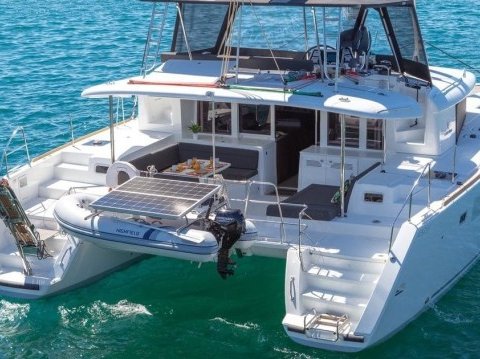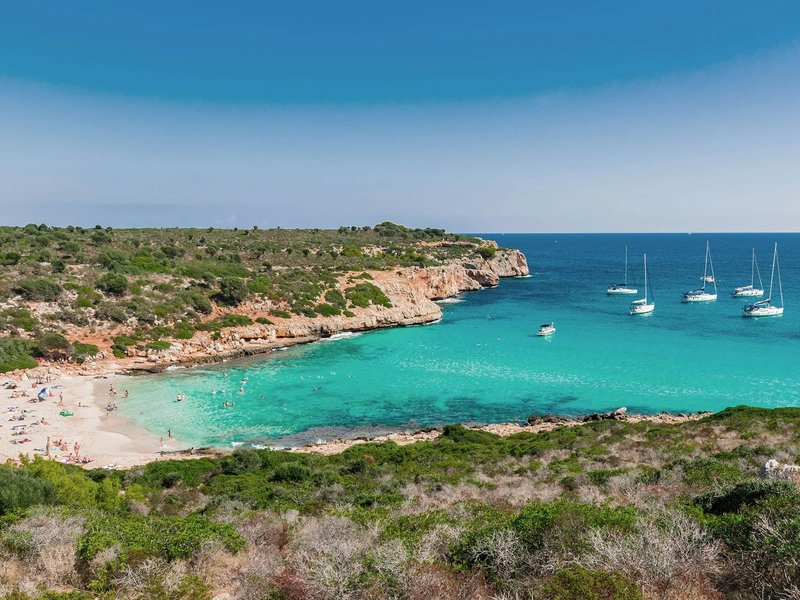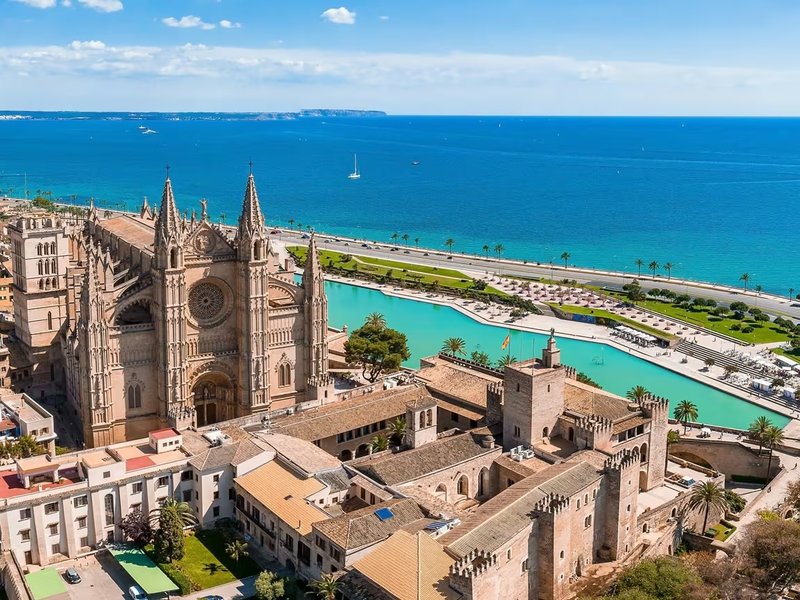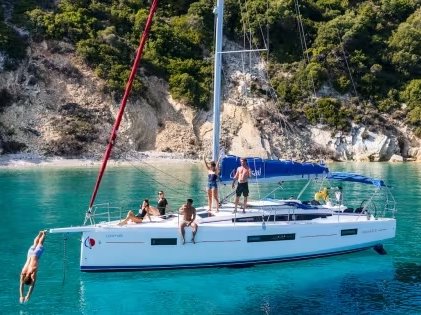Comprehensive Playbook for Buying and Co‑Owning a 4‑Stateroom Catamaran in the Mediterranean (2026–2031)
Have you ever dreamed of owning your own sailboat in the Mediterranean so you can sail away along sun‑drenched coasts and hidden coves? You're not alone. This guide invites you to imagine turning that dream into reality with friends by providing a step‑by‑step plan for selecting, buying and co‑owning a comfortable catamaran, and making the most of it over the next few years.
This playbook guides a group of 4‑8 friends through the process of purchasing and co‑owning a used catamaran (4 staterooms) in the Mediterranean. The group would first sail together for a couple of weeks on a rental, with a view to buying within several months of that first "test sail".
If you have a specific interest in considering something similar, email jeff@mallorcaguide.com to be included on future research and findings.
1 Choosing the Right Catamaran
1.1 Boat size and configuration
Four double cabins (staterooms) with en‑suite heads require a boat around 40–46 ft. This size offers a good balance of space and manageability; bigger cats (>50 ft) become substantially more expensive and difficult to moor. Well‑regarded 4‑cabin models include:
| Model (4‑cabin versions) | Approx. length×beam | Key features | Used price range (2025) |
|---|---|---|---|
| Lagoon 450 F | ≈13.96 m × 7.87 m; sail area 128 m² | Popular charter cat; comfortable saloon, flybridge and cockpit; good headroom; 4 cabins/4 heads. | US $400k–550k depending on age and upgrades. |
| Fountaine Pajot Helia 44 | 13.30 m × 7.40 m; draft 1.15 m:content | Well‑balanced design with bright saloon, large cockpit; Quatuor version offers 4 double cabins. | US $350k–500k. |
| Leopard 45/46 | ~13.72 m × 7.35 m; 4‑cabin models built 2017–2022. | Forward cockpit with access from saloon; robust build. A 2025 market guide lists tier‑3 ex‑charter Leopard 45s (4‑cabin) at US $380k–420k and tier‑2 boats with upgrades US $420k–689k | US $380k–600k. |
| Bali 4.6 | 14.28 m × 7.60 m; displacement 13.6 t | “Open‑space” concept—saloon and cockpit form one large area; solid foredeck; 4+1 cabins. | US $500k–650k. |
| Nautitech 44 Open | ~13.30 m × 7.36 m | Emphasis on sailing performance; dual helm stations at the stern; comfortable saloon. | ~US $450k–600k. |

Used vs. new: Buying a 3‑ to 5‑year‑old catamaran allows the boat to absorb the steepest depreciation. Catamaran Guru notes that boats depreciate ~15–20 % in the first year, ~12 % in the second year, and ~10 % in the third year.
After six–seven years the value tends to stabilize. Boats coming out of charter fleets after 4–5 years often sell for ≈40 % less than new; they rarely fall below 60 % of replacement value. Therefore, look for 2019–2022 models; they should cost US $380k–600k and still have modern equipment.
1.2 Factors when comparing models
- Layout: Look for four reasonably sized cabins with en‑suite heads. Some models offer “owner’s versions” (3 cabins + large master); avoid these since your group needs equal cabins.
- Sailing performance vs. comfort: Fast cruiser‑racers (e.g., Outremer) are expensive and compromise interior volume. Spacious charter‑oriented cats (Lagoon, Fountaine Pajot) prioritise comfort and are ideal for cruising with friends.
- Bridge‑deck clearance: Higher clearance reduces wave slap and increases comfort in choppy seas.
- Helm position and visibility: Some cats (Leopard, Bali) have forward or flybridge helms offering better visibility but can increase windage. Others (Nautitech) place helms at the aft corners for a sailing feel and easy docking.
- Systems: Evaluate engine hours, generator, watermaker, air‑conditioning, solar panels, and lithium batteries. Replacing worn‑out systems can be costly.

2 Cost of Acquisition
2.1 Purchase price
Assuming a used 2019–2022 catamaran with 4 cabins, budget US $300k–600k depending on model, condition and equipment. Factor additional costs:
- Survey and inspection: A professional survey (~US $1,500–2,500) is essential. Surveyors specialized in catamarans should be chosen. The survey may reveal hidden defects; allocate funds for immediate repairs.
- Taxes & EU VAT: EU residents must pay ~20 % VAT on boats used within the EU. Non‑EU residents can cruise in EU waters under Temporary Admission for up to 18 months without paying VAT. A VAT‑paid boat retains its status only if not significantly improved and re‑imported within three years.
- Registration & flagging: The flag state determines the laws onboard and affects charter permission, crew rules and inspections.. Popular offshore registers (Cayman Islands, Marshall Islands) offer flexibility and may lower taxes. Registering the vessel under an LLC can simplify multi‑ownership and limit liability.
- Financing costs: If financing, lenders often require the boat to be flagged in their jurisdiction, and interest rates may vary.
2.2 Depreciation and resale value
Assume depreciation of 15 % in year 1, 12 % in year 2 and 10 % in year 3, leveling off after year 6. A boat purchased for $500k in 2026 might be worth ~$300k–350k after five years. Condition, upgrades, market demand, and currency exchange rates significantly influence resale value.
3 Annual Operating Costs
Annual ownership costs typically equal 5–10 % of the boat’s value. For a $500k catamaran, plan for $30k–50k per year (≈€27k–45k). Major cost categories are outlined below.
| Cost item | Typical amount & details | |
|---|---|---|
| Mooring (marina) fees | €70–200 per night in for a 45‑ft boat, rising to €200+ in high season, with catamarans paying 50–60 % extra. Sample rates: ACI charges €114–€172 per night; marinas cost €30–100 per night with many inexpensive municipal quays. varies from €40 per night in low season to €425+ per night for 45 ft in high season and charge €20–190 per night with catamaran surcharges. Year‑round permanent berths for 40‑45 ft cats can cost €15k–20k per year. | |
| Maintenance & repairs | Plan 5–10 % of purchase price per year. Typical tasks include hull cleaning $500–1,500/yr, engine servicing $1,000–3,000/yr and sail maintenance $500–2,000/y. Other periodic tasks: haul‑out, antifouling, battery and rigging replacement (rigging ~every 7–10 years), safety gear, tender & outboard upkeep. Budget extra 10–15 % for unexpected repairs. | |
| Insurance | Catamaran insurance in the Mediterranean typically costs 1–2 % of hull value per year. For a $500k boat, premiums may be $5k–10k/yr; private‑use policies are ~1 % in the Med, while charter use or ocean crossings can push premiums to 2–3 %. Policy should include hull damage, protection & indemnity (liability), medical and environmental cover. | |
| Insurance deductibles & safety requirements | Premiums depend on vessel age, condition, value, cruising area and owner experience. Higher deductibles and limiting cruising area reduce cost. Marine insurers may require surveys, safety equipment (EPIRB, life‑raft) and hurricane‑season restrictions. | |
| Fuel & utilities | €2–4 per engine hour; catamarans have two engines and can burn 4–6 l/h each. Factor fuel for dinghy, generator and heating/air‑conditioning. Water and electricity in marinas often charged separately. | |
| Provisions & crew | Food, beverages and household goods vary by location and group size. Hiring a professional skipper or hostess costs €200–350 per day; not necessary if owners are experienced. | |
| Communications | Cellular SIM cards for data, satellite phone for emergencies, plus navigation software subscriptions. | |
| Taxes & navigation permits | Countries like and require cruising permits and tourist taxes. Factor ~€200–600 per season. | |
| Depreciation | Not a cash cost, but plan to lose ~40 % of purchase price over five years |
4 Seasonal Sailing & Routes in the Mediterranean
The Mediterranean sailing season runs April to October.
4.1 Seasonal considerations
- Peak season (July–August): Hot, dry weather and warm sea; marinas and anchorages are crowded; mooring fees are highest. Ideal for social sailing and festivals.
- Shoulder seasons (April–June and September–October): Pleasant temperatures and reliable winds; fewer crowds; lower prices. These months are recommended for comfortable cruising.
- Winter (November–March): Many marinas close or reduce services; weather can be cold and stormy; storms like the Mistral (), Meltemi () and Maestral () blow strongly:contentReference[oaicite:35]{index=35}. Off‑season is ideal for maintenance and upgrades.
4.2 Highlights and route ideas
| Region | Highlights | Best months | Notes |
|---|---|---|---|
| (, , , ) | Whitewashed villages, historic sites (, ), turquoise bays, tavernas. The Meltemi brings strong northerly winds in July–August, offering exhilarating sailing:contentReference[oaicite:36]{index=36}. | May–June & Sept–Oct; July–Aug for lively atmosphere. | Many small harbors have inexpensive or free quays; island‑hop easily. |
| (, , & ) | Medieval towns (, ), hundreds of islands, clear waters, vineyards. The Maestral (north‑westerly) provides steady afternoon breezes. | May–June & Sept; high season crowded. | Anchorages well protected; mooring buoys cost ~€50–90/night; national park permits required. |
| (, & , & ) | Dramatic cliffs, chic ports (, ), volcanic islands (), culture & cuisine. | May–June & Sept–Oct; July–Aug for festivals. | Mooring expensive in hotspots ( €205–300/night for 45 ft; anchor outside marinas when possible. |
| & Corsica | Glamorous (, ), wild Corsican coast, . | June & Sept; high season bustling. | Mooring fees high; plan reservations early. |
| , & Turkey | Historic harbors (), unspoilt bays (, ), long sailing seasons. | Apr–Oct; early/late seasons for quiet. | Combine with or itineraries. |
Mallorca, Spain , , Formentera) | Secluded calas, lively nightlife, UNESCO sites (, ). | May–June & Sept; July–Aug busy. | Anchor taxes in Balearic Islands; marinas in Palma de Mallorca & expensive. | | & Corsica | Glamorous (, ), wild Corsican coast, . | June & Sept; high season bustling. | Mooring fees high; plan reservations early. | | , & Turkey | Historic harbors (), unspoilt bays (, ), long sailing seasons. | Apr–Oct; early/late seasons for quiet. | Combine with or itineraries. |

5 Ownership Structure & Legal Considerations
5.1 Co‑ownership models
Syndicate/LLC (equity sharing): Partners form a limited liability company. Each member owns shares (e.g., 1/5 each) and holds title to the boat. The Catamaran Guru fractional ownership programme caps ownership at 5 shares; each partner receives an equity stake and the ability to sell their share anytime. At the end of the programme (7 years), the boat is sold and proceeds distributed. Your group could adapt this model to a 5‑year horizon.
- Fractional ownership with management company: Owners buy 1/4 to 1/12 shares and sign a management contract. The share size dictates weeks of use (often 3–6 weeks). The company handles maintenance, insurance and scheduling; unused weeks may roll over.
Pros: lower cost and professional management. Cons: limited customization and competition for weeks.
- Private partnership contract: A custom agreement among friends. A boat‑sharing agreement should define ownership rights, cost division (purchase, mooring, maintenance, taxes), insurance, damage responsibilities, scheduling, dispute resolution and procedures for selling the boat or shares.
Yachting lawyers stress the importance of a written syndicate agreement, contingency funds for maintenance and emergencies, rules for transferring shares, and informing insurers about the syndicate.
5.2 Structuring for 4–8 investors
- Entity formation: Create an LLC or equivalent in a jurisdiction acceptable to all investors. The LLC owns the boat; investors own shares. This limits liability, simplifies financing and facilitates transfer of ownership shares.
- Shares & capital: Divide into equal shares (e.g., four investors @ 25 % each or eight investors @ 12.5 %). Each investor contributes cash for the purchase and deposits funds into a maintenance reserve (e.g., €10–15k per year). Some owners may contribute more in exchange for extra usage or larger cabins.
- Operating agreement: Document responsibilities:
- Financial contributions: monthly/annual payments to cover mooring, insurance, maintenance and repairs. Use a separate bank account.
- Scheduling: allocate prime weeks (high‑season) and shoulder weeks. A common approach is a rotating schedule where owners pick weeks in a draft order that rotates annually; unused weeks can be swapped or sold. Syndicate programmes often grant each partner two weeks per year plus unscheduled time.
- Rules of use: restrictions on smoking, pets, number of guests, chartering to third parties, etc.
- Damage & repairs: define liability for damage caused by negligence; require all partners to take a recognized sailing course before operating the boat.
- Insurance: ensure all owners are named insured or declared to the insurer.
- Exit strategy: Decide when the boat will be sold (e.g., after 5 years). Include buy‑out clauses allowing partners to exit earlier for health or financial reasons. A departing partner must offer their share first to existing members at fair market value. If there is no buyer, the company may charter the boat to fund a buy‑back. A contingency fund should cover unexpected repairs so that an unplanned exit does not cripple operations.
5.3 Insurance & liability considerations
- Coverage types: Marine insurance should include hull & machinery (physical damage), protection & indemnity (liability), medical coverage, search & rescue and environmental damage. Additional cover for charter, regattas, and ocean crossings may be needed.
- Premium factors: Age, length, value, speed, condition, home port, and operating area influence premiums. The Mediterranean has relatively low premiums (~1 % of value), whereas U.S. hurricane zones or trans‑ocean crossings increase cost.
- Reducing premiums: Limit cruising area, avoid hurricane seasons, increase deductibles, and undertake formal sailing/boating courses.
5.4 Tax & flag considerations
- VAT: As noted, EU residents must pay VAT (~20 %); non‑EU owners can operate under Temporary Admission for 18 months:contentReference[oaicite:53]{index=53}. A VAT‑paid boat retains its status only if it stays within the EU; leaving for more than three years may forfeit VAT‑paid status.
- Flag state: Choose a flag that suits the group’s nationality and use (private vs. commercial). Reputable flags (Cayman Islands, Marshall Islands) simplify insurance and reduce inspections. Flagging offshore may avoid certain taxes, but some lenders require U.S./EU flagging for financing.
6 Operational Considerations & Lifestyle
6.1 What owners enjoy
- Stability & space: Catamarans provide large saloons, cockpits and cabins. The Lagoon 450 F emphasises comfort and natural light. Nautitech notes that catamarans’ shallow draft and stable platform allow anchoring close to shore and provide a relaxed ride.
- Easy maneuvering: Having two engines allows the boat to pivot on the spot, making docking easier. Once accustomed to the size, owners find that catamarans are often easier to berth than monohulls.
- Comfortable living: Wide living areas create separate zones (cockpit, trampolines, salon) providing privacy; natural light and ventilation support long stays. The open concept allows socializing and enjoying Mediterranean outdoor living.
- Autonomy & freedom: Liveaboard guides highlight the appeal of a slower pace, constant movement, and deeper connection with nature and family. Catamarans enable exploring secluded anchorages and shallow lagoons that monohulls cannot reach.
- Minimal heel: Catamarans remain largely upright, reducing seasickness and providing stable platforms for dining and relaxing.

6.2 Common surprises and downsides
- Higher costs: Catamarans are more expensive to purchase and charter. Their complex twin‑hull design, two engines, multiple heads and more square footage mean higher maintenance and repair costs:contentReference[oaicite:64]{index=64}. Marina fees often add 50–75 % surcharges due to the wider beam.
- Maneuvering challenges: The wide beam makes it difficult to find marina slips; tight manoeuvring requires practice.
- Performance limitations: Catamarans generally struggle to sail upwind and may be slower in light air due to higher weight. In rough seas, the jerky motion between the hulls can be uncomfortable.
- Learning curve: Sailing a catamaran requires different techniques for tacking and gybing; specialized training is recommended.
- Duplicate systems & maintenance: Living aboard means maintaining two engines, two drives, two heads and more equipment; things break often, so owners must learn to be mechanics, plumbers and electricians.
- Resource management: Cruising involves constantly monitoring power, fresh water and waste management. Provisioning and storage require planning..
- Limited privacy: The openness that makes cats social can reduce privacy; cabins are closer together.
Menziato in Questa Guida
Esplora tutte le località menzionate in questa guida sulla mappa qui sotto.
Palma
Palma, Balearic Islands, Spain
Formentera
Formentera, Balearic Islands, Spain
Corsica Ferries Alcudia
Unnamed Road, Illes Balears, Spain
Ristorante Bella Istambul
Carrer Uetam, 7, Llevant, 07006 Palma, Illes Balears, Spain
Majorca
Majorca, Balearic Islands, Spain
